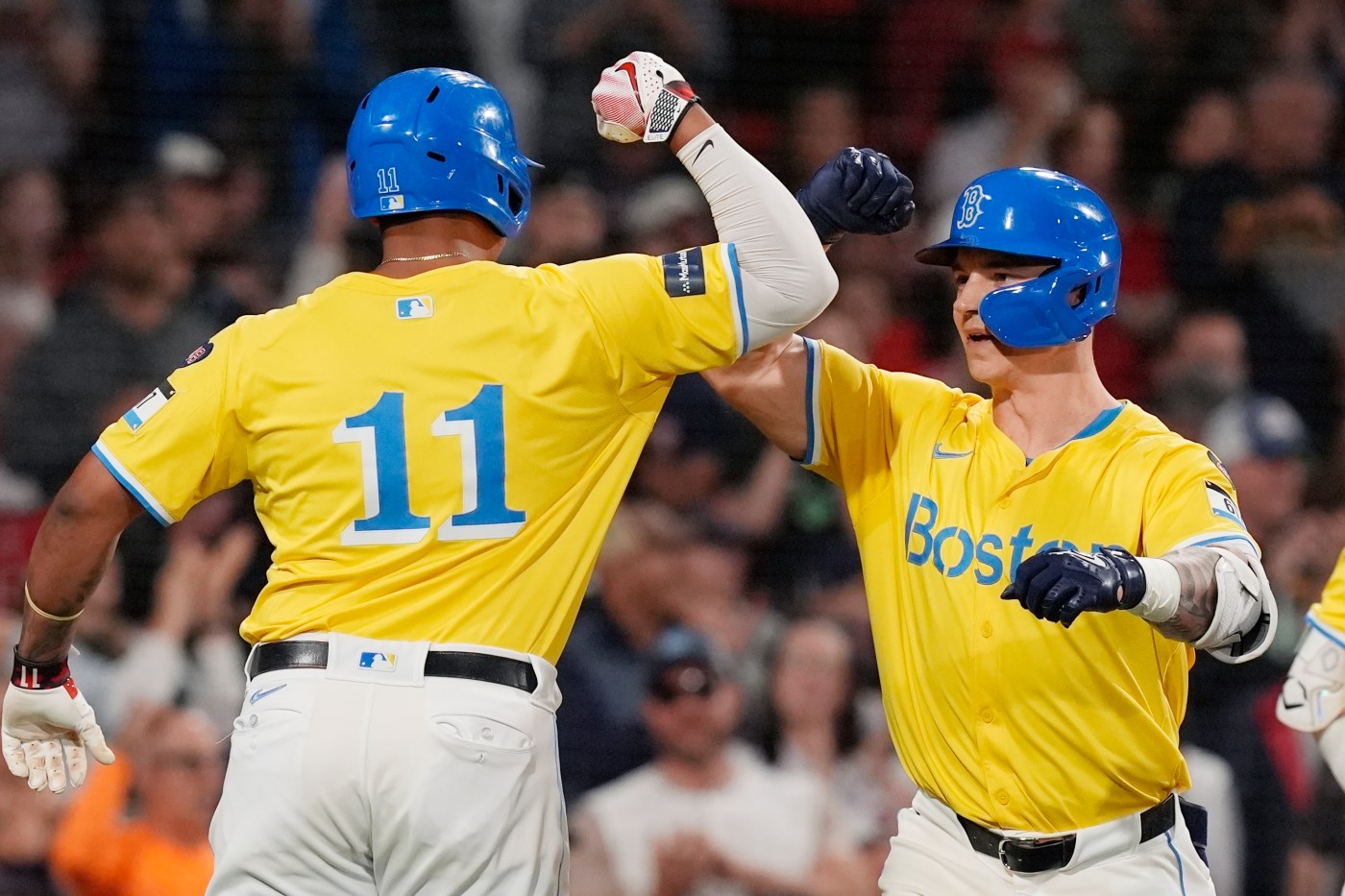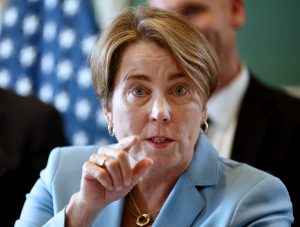
MLB notes: Red Sox marketing boss weighs in on new uniforms, Netflix success
Adam Grossman doesn’t have any say over the roster, and he can’t influence how the team performs on the field, but the Red Sox chief marketing officer still plays a big part in building buzz around the club.
Though the club has endured a couple of challenging years, several major undertakings are coming to fruition right as the Red Sox look poised for a return to relevance.
Last year the Red Sox partnered with Netflix to create two documentary series featuring the team, and the first of those — “The Comeback: 2004 Red Sox” which tells the story of the team’s historic triumph over the New York Yankees — was released to great fanfare this past month.
The second series, which will provide an unprecedented glimpse behind the scenes of the 2024 season, will debut at some point next year, as will a new alternate uniform.
Speaking to the Herald, Grossman expressed excitement for what the next few months could bring while shedding light on some of the club’s upcoming initiatives.
“‘The Comeback’ provided a really nice jolt for us,” Grossman said. “It was really fun and I think we sort of felt that energy and I think we will have another round of that when the next doc comes out.”
On the uniform front, Grossman announced at the end of the season that the Red Sox are in the process of developing a new City Connect design. Grossman said the new uniform will be unveiled at some point in 2025, but that while they haven’t finalized a date for the reveal, it won’t happen during the offseason.
That means fans shouldn’t expect to see the new uniform under the Christmas tree this holiday, and for those curious about what it will look like, Grossman isn’t giving much away.
“It’s new,” he said with a laugh. “I’m not going to be able to divulge much of anything, that’s part of the beauty of these things. There is anticipation and we think fans will enjoy it.”
Unlike other clubs who have retired their original City Connects in favor of new designs, the Red Sox opted to keep their yellow Boston Marathon-themed look as part of their primary uniform rotation. The club instead plans to retire the navy blue alternate it has frequently worn on the road in recent years, and which the club sported while clinching the 2018 World Series championship.
Why? The yellow City Connects have proven wildly popular, and Grossman said it wouldn’t have been in anyone’s best interest to move on.
“You see yellow every game at Fenway now. We felt like it worked and it resonated and when that happens, you know what, let’s keep them,” Grossman said. “The story is cool, the uniforms are cool, fans like them, players like them, and they’re bold.”
“Our hope and our goal is that we can create things that are lasting,” Grossman added. “This happened to be one that really clicked.”
As for why the Red Sox can’t just keep the navy blue alternate and add the new City Connect as a sixth uniform design, Nike has a “four-plus-one” policy that recommends MLB clubs stick to four primary uniforms plus a City Connect. Going forward Boston’s primary designs will be the classic home whites and road grays, the red alternate and the yellow City Connect, which will take the navy blue’s place in the primary rotation while clearing a spot for the new City Connect.
There is some flexibility in the policy, which allows the Red Sox to wear their special “Boston” uniforms on Marathon Monday, but that’s essentially a modified home white and is a fairly straightforward change for Nike to accommodate.
Fans can expect other uniform changes as well.
Following the disastrous rollout of Nike’s new Vapor Premier uniform — which was widely panned by fans and players alike for its cheap appearance, small lettering and lack of customization, among other issues — MLB recently announced it plans to go back to the previous uniform template used through 2023. Though the switch won’t be fully implemented until 2026, certain design aspects will be ready by next season.
The most obvious difference will be the return of larger lettering on the back of players’ jerseys, which an MLB source confirmed would be in place by Opening Day.
As far as Netflix goes, Grossman said production on the 2024 series is well into the editing phase and that some additional footage was filmed after the season wrapped up last month. He said the organization is excited to see the finished product, especially after “The Comeback” enjoyed so much success.
“The feedback we’ve received has been overwhelmingly positive,” Grossman said. “I think it topped out at No. 6 in the top 10 on Netflix, and I don’t want to speak for Netflix but I think they were very pleased with the way the viewership not only started but how it has continued to grow.”
Though Netflix declined to comment on specific viewership numbers, a company spokesperson confirmed that “The Comeback” peaked at No. 6 in the U.S. and ranked No. 9 on the service domestically for the week of Oct. 28 through Nov. 3. It also performed exceptionally well in the Dominican Republic, where it debuted at No. 1 on the service and remained No. 2 for the week of Oct. 28.
Beyond the viewing totals, Grossman also said the club was pleased with how the series seemed to break through into the cultural mainstream, garnering attention from outlets and audiences that typically don’t pay attention to baseball. It also resonated with younger audiences who weren’t old enough to experience the 2004 Red Sox or the ‘Curse of the Bambino’ for themselves, he said.
“My kids, who are 12 and 10, obviously weren’t around for that, and they were completely hooked,” Grossman said. “So I think we’re seeing why these platforms are so important in growing connectivity to a team and to a sport.”
Obviously a Netflix special can only get you so far — the club needs to fulfill its promise to improve the team and win more games — but if the Red Sox are able to make the leap back into contention, these projects could help boost them back to a level of relevance we haven’t seen in years.
Kennedy says Red Sox plan to spend
Over the past few years Red Sox CEO Sam Kennedy has made a point not to comment on the club’s payroll plans, saying that doing so would put the club at a competitive disadvantage.
That logic has never made much sense — other teams publicly discuss their payrolls all the time — but it was noteworthy that Kennedy dropped the pretense this week and directly acknowledged that the club plans to increase spending this coming season.
Speaking to Michael Silverman of The Boston Globe at the MLB Owners Meetings, Kennedy said the Red Sox are ready to spend, even if it means exceeding the luxury tax and even if it means taking on the kind of mega deal the club has been wary of committing to in the past.
“If that’s what it takes, yeah, absolutely,” Kennedy said. “We are investing more than we did last year. We intend to invest going forward.”
According to @RedSoxPayroll on Twitter/X, the Red Sox carried a payroll of $225.74 million in 2024 and were approximately $11 million below the first Competitive Balance Tax threshold, which last season was $237 million. This year that threshold will rise to $241 million, and as of this writing the Red Sox currently have $178.31 million committed for 2025.
That means the Red Sox are more than $62 million under the first threshold and $82 million under the second, giving the club a huge amount of financial flexibility to work with. If the club is serious about spending, it should have more than enough money to pursue any free agent on the market.
That includes Juan Soto, the 26-year-old superstar who is expected to command a deal in excess of 12 years and $600 million. The Red Sox are among a handful of teams known to have met with Soto, and by all accounts the club seems to be a serious player for his services. Even if Soto signs elsewhere, the Red Sox could also turn around and sign one of the top free agent pitchers — Corbin Burnes, Max Fried, Blake Snell — or perhaps it could even do both.
Actions speak louder than words, so the Red Sox will at some point have to put their money where their mouth is. But after five years of waffling and treading water, hearing Kennedy speak with such urgency and clarity is a refreshing change that should hopefully portend better days ahead.
Challenge system coming to spring training
After years of testing in the minor leagues, a version of MLB’s new automated strike zone system will reportedly be used during spring training this coming year with an eye towards full implementation in the majors in 2026.
According to Evan Drellich of The Athletic, the automated ball-strike challenge system will be used in select spring training parks, giving major league clubs and players an opportunity to experience it for themselves and provide feedback ahead of the technology’s full adoption.
Under the challenge system, balls and strikes are called by the home plate umpire like normal, but batters, pitchers and catchers have the ability to challenge calls they disagree with. The automated ball-strike system, which utilizes pitch tracking technology and an electronic strike zone to call pitches, would then determine whether the pitch is a ball or a strike and the result of the challenge would be displayed on the ballpark’s big screen.
Teams are also granted a limited number of challenges, which they can retain if a challenge is successful. The entire process usually takes just a few seconds and functions similarly to the challenge system used in tennis.
Unlike the full ABS system, in which all pitches are called electronically and relayed to the home plate umpire, the challenge system preserves the human element while allowing an avenue for missed calls to be corrected. The system would probably eliminate the big arguments and manager blowups that have been a feature of the game since the beginning, but would also bring more consistency and represent another needed innovation for the sport.


